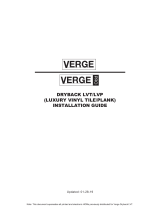RESIDENTIAL RESILIENT MAINTENANCE
Proper care will help protect and maintain the appearance and performance of your resilient floor.
A Care Program Consists of Key Areas:
1. Post-Construction Maintenance
2. Preventative Maintenance
3. Routine Maintenance
4. Spot and Spill Removal.
For New Construction or Renovation: Construction dust and joint compound can be deposited on the flooring. If it is not completely
removed and then wet mopped, it will create a haze on the surface of the flooring.
POST-CONSTRUCTION MAINTENANCE
Dry mop floor using a microfiber mop pad or appropriate floor vacuum to remove dust particulate from the floor.
Spray neutral pH cleaner, such as Shaw TOTALCARE® Hard SurfaceCleaner or equivalent neutral pH floor cleaner, onto the
floor in manageable areas (spray mist will dry quickly). Use a microfiber wet mop pad to mop the floor with cleaner. If pad
becomes dirty, be sure to replace the pad with a new microfiber wet mop pad. Mop floor in sections.
Always rinse the floor with water only by mopping with water to remove any remaining residue from the floor.
In the event where dry wall dust/construction dust is mopped with water only, a residue film will appear on the floor after drying. Use
the process below to remove the film from the floor.
PROCESS TO REMOVE CONSTRUCTION RESIDUE OR CLOUDY FILM FROM RESILIENT FLOORING
1. Dry mop floor to remove any construction dust or exterior soil tracked onto the flooring. Use microfiber dry mop pad. If
microfiber dry mop pad gets dirty, replace pad with a clean pad.
2. Spray neutral pH cleaner, such as Shaw TOTALCARE® Hard SurfaceCleaneror equivalent neutral pH floor cleaner onto the
floor in manageable areas (spray mist will dry quickly). Clean floor in sections. For smooth surface, use a low rpm (175 rpm)
buffer with a 3M red pad on flooring with neutral pH cleaner applied to the floor to remove the residue film. (Never Dry Buff). For
embossed or textured flooring, use a cylindrical brush scrubber, such as the Clark MA10 12E Scrubber and a neutral pH floor
cleaner applied to the floor to remove the residue film.
3. Using a wet microfiber mop pad, rinse with water only to remove any remaining residue from the flooring. When wet mop pad
becomes dirty, be sure to replace the pad with a new microfiber wet mop pad.
4. Repeat steps #2 and #3, if necessary.
When the resilient flooring is cleaned properly, the floor will have the same visual as right out of the box!
PREVENTATIVE MAINTENANCE
Always protect floors when moving heavy objects to prevent permanent scratches and tears.
Adhering tape to the surface of your resilient flooring could damage the surface.
Do not use tape to secure floor protection directly to the floor during construction or renovation. Instead, adhere tape to the
material used to protect the floor and secure it to the base molding along the wall. A material such as ram board can also be
used to protect yourflooring.
To protect your flooring from indentations that can result from stationary furniture and appliances, floor protectors under the
furniture should be used to distribute the weight load. Chair pads should be used under desk chairs to prevent damage from the
castor wheels.
Place chair pads underneath rolling chairs to prevent damage to the LVT flooring.
Walk-off mats should be used at all entrances to absorb soil and moisture. If mats are placed directly on top of the resilient
floors, use mats without latex or rubber backings to avoid possible discoloration.
1
For reference purposes only if printed or downloaded.


